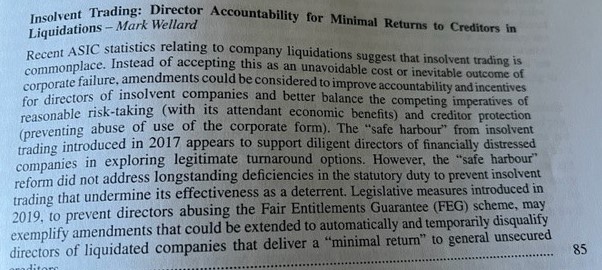This is a brief response to a well-researched and thoughtful article by Associate Professor Mark Wellard – Insolvent Trading: Director Accountability for Minimal Returns to Creditors in Liquidations (2023) 31 Insolv LJ 85.
The article refers to comments that Jason Harris and I make about the need to attend to assetless insolvencies, including by way of creating an official receiver role. Wellard argues that, instead, as a matter of law reform, we should work harder to preserve assets in a failing company by way of revamping the insolvent trading prohibition and other regulatory measures, so as to cause directors to act earlier, or deter them from trading on, and therefore minimise the outcomes of so many companies going into liquidation with no or minimal assets.
Merely changing the law?
My response is that just as I still have a fatalistic view about the inevitability of low or nil returns in most insolvencies, likewise do I think that however much we tweak the law, things won’t change much. We all expect too much of the law, generally, in particular its deterrent effect, particularly in a business environment where, for example, s 588G is but one of many laws potentially imposing liability. And, insolvent trading is one of the lesser items of misconduct among rather low standards generally, in my view.
Deterrence
Putting this in perspective, how many solvent MSME companies would be trading while insolvent at times, and in the vast majority of cases, nothing comes of it? Deterrence has to work on the minds of directors in that limited perspective. It might start to work if a few select cases succeed in creating a perceived probability of apprehension and of liability, supported by regulators’ use of the media to heighten directors’ perceptions of such probability: in the context of phoenixing, see Hedges et al The Potential Economic Gains from Increasing Public Law Enforcement against Illegal Phoenix Activity.
But deterrence needs prompt action, and section 588G liability is so contingent and distant in prospect, I doubt deterrence has much potential at all: see my The Empty Threat of Insolvent Trading (2009) INSLB 126. See also R Williams’ What Can we Expect to Gain from Reforming the Insolvent Trading Remedy? (2015) 78 Modern Law Review 55, who concludes there is no basis to suppose that reform of the law of (UK) wrongful trading would ‘yield a significant upswing in returns for creditors’; he also examines s 588G. And if liability is imposed, many directors go bankrupt.
The law seems to assume a neat corporate business operation encompassing all debts and assets, when the reality is often that there are personal guarantees, personal funds and liabilities, that all constitute “the business”. Do we expect the average MSME director to always have an accurate balance sheet and to discern who is incurring the debts and from which funds?
In other words, “insolvent trading or not, and creditor-defeating dispositions or not, financial outcomes for creditors won’t change, and by the time action is taken, creditors will have moved on and their need for justice will by then have faded”: Does insolvent trading work? The UK may not think so. – Murrays Legal
Costs
As to the costs of bringing a s 588G, or any recovery claim, I have asked this before – what is the average outcome for creditors from IPs’ “successful” litigation claims after remuneration and legal expenses are paid? In the absence of a response from the profession, or I should say industry, I’ll go with the PJC’s finding, of virtually nil.
%
And even if we succeed in getting ‘increased returns’ to creditors, what are we aiming for? A 100% increase might take them to 4c/$?!
Crime
As to criminal matters, the 2009 collapse of Kleenmaid resulted in a plea of guilty 13 years later, in 2022, to s 588G(3) criminal insolvent trading, with six months jail imposed but with immediate release on a recognisance.
Banning
Banning directors is probably better than getting judgment against their limited or no asset position. But are we really going back to penalising failure, however inept?
Automatic banning or reversing the onus of proof might be ok, but note that attempts at a default process of banning directors for not providing the RATA or books has been rejected. And it must be subject to review.
Would we go the way of s 33D of the NSW Home Building Act and require the director to show that they “took all reasonable steps to avoid the relevant bankruptcy, winding up or appointment of a controller or administrator”?
Director IDs
And the government is not helping creditors by being yet to decide whether director IDs should be publicly searchable. And while ever single touch payroll remains halted at reporting only, and not payment, there will be large tax debts owed to the ATO that will invariably swamp the average trade creditor, with directors’ concerns about DPN liability probably relegating any section 588G liability way down the list.
Not forgetting the creditors
As to creditors, there are self-help avenues, eg under the PPSA, that are available.
I don’t disagree with attempts to sharpen up the law in this area, as Mark Wellard suggests, but I doubt they would have the effect he wants, and a change of culture has to follow, which can take a while. In the meantime, I think there are good reasons to attend to low and no asset insolvencies, including those that are unable to access, or that avoid, the system. See also Some insolvency law reform ideas from Scotland and New Zealand – Murrays Legal
Michael Murray



